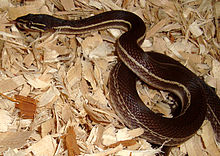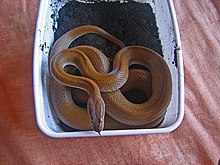| Boaedon | |
|---|---|

| |
| Striped house snake, Boaedon lineatus. | |
|
Scientific classification
| |
| Domain: | Eukaryota |
| Kingdom: | Animalia |
| Phylum: | Chordata |
| Class: | Reptilia |
| Order: | Squamata |
| Suborder: | Serpentes |
| Family: | Lamprophiidae |
| Subfamily: | Lamprophiinae |
| Genus: |
Boaedon A.M.C. Duméril, Bibron, & Duméril, 1854 |
| Species | |
|
22 recognized species, see text. | |
Boaedon is a genus of African lamprophiids consisting of the "brown" house snakes. The genus was originally described by Duméril but the species contained were reclassified as Lamprophis by Fitzinger in 1843, this taxonomy remained widely accepted until November 2010 when a phylogenetic study was published by C.M.R Kelly et al. who resurrected the Boaedon clade. [1] Although commonly regarded as belonging to the Colubridae, primary literature usually lists them and related species as belonging to the family Lamprophiidae within the superfamily Elapoidea, which includes the venomous cobras and mambas. [1]
Species
There are currently 22 species placed within the genus Boaedon, with new and updated ones occasionally being described.
- Angolan house snake, Boaedon angolensis Bocage, 1895
- Boaedon bedriagae Boulenger, 1905 [2]
- Bocage’s brown house snake, Boaedon bocagei Hallermann, Ceríaco, Schmitz, Ernst, Conradie, Verburgt, Marques, & Bauer, 2020
- Branch’s brown house snake, Boaedon branchi Hallermann, Ceríaco, Schmitz, Ernst, Conradie, Verburgt, Marques, & Bauer, 2020
- Cape house snake, Boaedon capensis Duméril & Bibron, 1854
- Frade’s brown house snake, Boaedon fradei Hallermann, Ceríaco, Schmitz, Ernst, Conradie, Verburgt, Marques, & Bauer, 2020
- Brown house snake, Boaedon fuliginosus Boie, 1827
- Seychelles house snake, Boaedon geometricus Schlegel, 1837
- Striped house snake, Boaedon lineatus Duméril & Bibron, 1854
- Coastal house snake, Boaedon littoralis Trape & Mediannikov, 2016
- Long-lined house snake, Boaedon longilineatus Trape & Mediannikov, 2016
- Dotted house snake, Boaedon maculatus Parker, 1932
- Boaedon mendesi Ceríaco, Arellano, Jadin, Marques, Parrinha & Hallermann, 2021 [2]
- Namibian house snake, Boaedon mentalis ( Günther, 1888)
- Boaedon montanus Trape, Mediannikov, Hinkel, & Hinkel, 2022
- Olive house snake, Boaedon olivaceus ( Duméril, 1856)
- Central African lined house snake, Boaedon paralineatus Trape & Mediannikov, 2016
- Boaedon perisilvestris Trape & Mediannikov, 2016
- Radford's house snake, Boaedon radfordi Greenbaum, Portillo, Jackson, & Kusamba, 2015
- Yellow house snake, Boaedon subflavus Trape & Mediannikov, 2016
- Boaedon upembae ( Laurent, 1954)
- Boaedon variegatus Bocage, 1867
- Hallowell's house snake, Boaedon virgatus ( Hallowell, 1854)
Appearance
All members of the genus Boaedon are small snakes, generally attaining lengths of little more than 4 feet (120 cm) in length. Sexually dimorphic, females are always larger than males who attain lengths of approx. 2 feet (60 cm) there is some variance between species and between geographic locales of species.

Overall body colouration is typically sandy brown to black but green, orange, red and a variety of other locale specific variations do exist. All species are nocturnal by nature and present with vertically elliptic pupils, they also present with few exceptions a v-shaped set of stripes stretching from the rostral scale through the eye to the rear of the head. Body pattern varies between species, B. olivaceus, B. upembae, B. mentalis, & B. fuliginosus are all naturally pattern less, B. capensis and B. maculatus both have patternless variants and B. lineatus typically has lateral striping running the length of the body. These are highly variable snakes and confusion is common when attempting to distinguish them from one another.
Geographic range
House snakes occur in all of sub-Saharan Africa, inhabiting dense forests and deserts as well as all other habitats in between. They are commonly found around towns where they will feast on the rodents which gather there.
External links
References
- ^ a b Kelly, C.M.R., et al. Molecular systematics of the African snake family Lamprophiidae, Fitzinger, 1843 (Serpentes: Elapoidea), with particular focus on the genera Lamprophis, Fitzinger 1843 and Mehelya, Csiki 1903. Mol. Phylogenet. Evol. (2010), doi: 10.1016/j.ympev.2010.11.010
- ^ a b Ceríaco, Luis MP; Arellano, Ana Lisette; Jadin, Robert C.; Marques, Mariana P.; Parrinha, Diogo; Hallermann, Jakob (2021-01-15). "Taxonomic revision of the Jita snakes (Lamprophiidae: Boaedon) from São Tomé and Príncipe (Gulf of Guinea), with the description of a new species". African Journal of Herpetology. 70 (1): 1–31. Bibcode: 2021AfJH...70....1C. doi: 10.1080/21564574.2020.1832152. ISSN 2156-4574. S2CID 234262958.